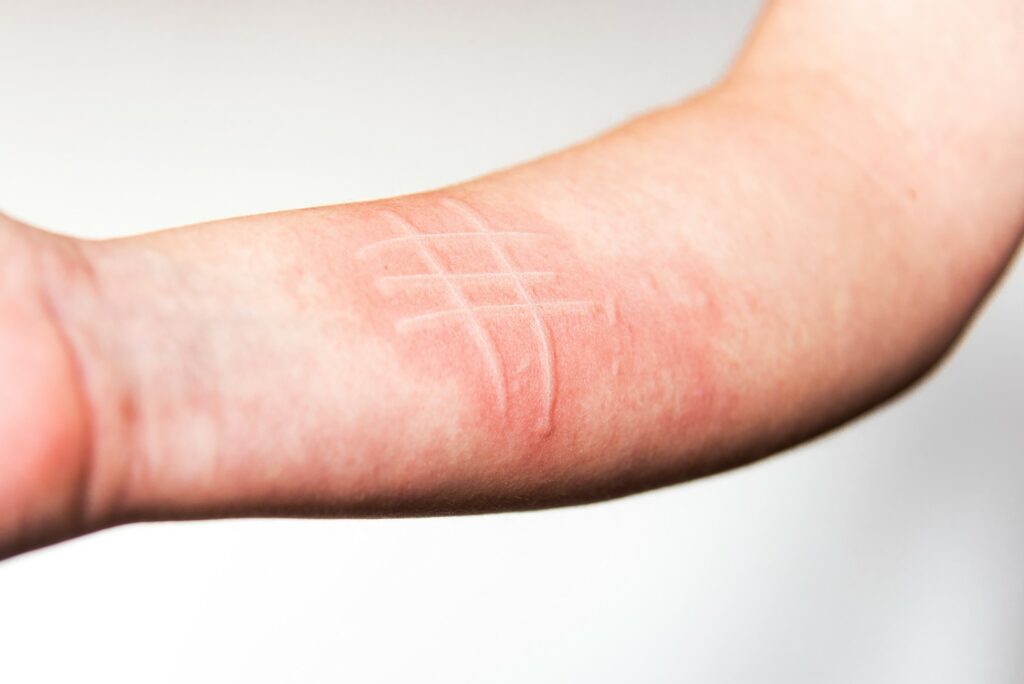Dermatographia: Facts About a Common Skin Condition

If you have ever scratched your skin and the scratches become raised spots on the skin or welt up, this skin condition is called dermatographia. Dermatographia may appear as lines, which is how it got its name from skin writing. Things like rubbing, pressure, and scratching cause the skin to react, and although it usually goes away on its own within half an hour, sometimes what is called skin writing may concern some people, and by understanding what it is, what causes it, and how to treat it can help ease overcome these reactions.
How Common is Dermatographia?
Skin writing is common and affects around 5% of the general population. The raised marks can become more irritated with continued friction and pressure. Anyone may experience dermatographia, but some are more likely to experience it if they are in their teens or under the age of 20, have dry skin, or have dermatitis. It is a skin condition that is frequently passed down through generations. Although the welts do not hurt, they can cause discomfort if they become itchy, making those with the condition self-conscious. These welts usually go away after about half an hour.
The symptoms vary from person to person, but the most typical signs are discolored or raised lines in pink, purple, or red. The lines will swell and become inflamed; sometimes, these welts may become itchy and look like hives.
Although dermatographia’s exact causes are unknown, there are several triggers: allergies, exercise, extreme heat or cold temperatures, and some medicines may cause a person to be more likely to experience these raised welts. Many who suffer from dermatographia claim that stress causes the skin to react, and reducing stress can help minimize flare-ups. Some known ways to reduce stress are counting to 10, staying active, monitoring intake of alcohol and caffeine, getting a good night’s rest, staying positive, and staying in the community with others.
It is thought that the skin reaction is an immune system response to an allergen. Suppose dermatographia is an auto-immune disease, which some believe. In that case, the body thinks the pressure and scratching are allergens, and it sends histamine to remove the allergen from the body. It is not contagious and should not concern those with visible welts.
How Can Dermatologists Help with Dermatographia?
Visiting a professional dermatologist can help diagnose and treat this condition. The consultation will involve agitating the skin by scratching or pressing the skin on the arm with a tongue depressor. The welts will appear within a few minutes of the agitation. The marks or welts appear where the agitation occurs and may appear like writing, hence the name skin writing.
Treatments for Dermatographia
Although the symptoms are mild, some seek assistance in treating the reaction for faster results. The signs often go away within thirty minutes, but when they don’t, here are some other options:
- Antihistamines can be purchased over the counter.
- A licensed dermatologist can issue prescriptions in severe cases that will block the reaction.
- Topical creams can be applied to the welts and quickly shrink welts and lines.
- Injections can be done during a short office visit at your local dermatologist in cases where other treatments do not work.
Considerations for Antihistamine Use
Antihistamines can be purchased, but knowing potential side effects can avoid alarm. Some commonly known side effects of over-the-counter antihistamines are drowsiness, dryness of the eyes and mouth, headaches, dizziness, sore throat, and dry coughing. These symptoms do not happen to everyone, but if they do occur, it is best to stop use and consult a licensed professional who can ensure you get the treatment you seek that fits your lifestyle.
Preventing Dermatographia
If you suffer from skin writing, one of the best ways to approach this condition is to take measures to reduce the risk of developing signs. It is easier said than done, but one of the best ways to avoid a breakout is to avoid scratching the skin, wear loose clothing, and stay away from scratchy and thick materials, like wool. Sticking to mild cleansers for bathing, patting skin dry instead of roughly rubbing it, and immediately following up with a cream or ointment can be tremendously helpful. Room humidifiers can add moisture to the room and help skin stay hydrated, reducing the temptation to scratch. Showering with water not scorching hot and learning stress management techniques are also known to help avoid symptoms.
Expectations of Dermatographia
If the welts on the skin do not go away within an hour of appearing or they become painful, see a professional dermatologist immediately. Extreme symptoms may be a sign of another skin condition. Experienced and licensed dermatologists can treat all skin conditions and get people the relief they seek. If you have questions or concerns about your skin, contact Buckhead Dermatology today for an appointment with Dr. Sherrie Straughn, who has dedicated her career to helping people manage and treat their skin.
